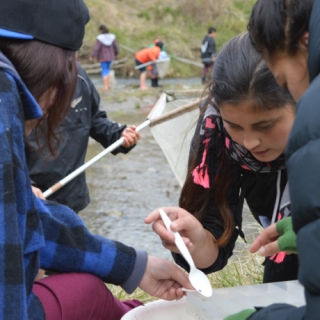FEATURED STORIES
Case Studies & Initiative Journeys
Case Studies described here are real examples of how an organisation has used an approach in Aotearoa New Zealand. Contact the featured organisation if you want to find out more. Please contact us to find out if there is a case study you think might be good to profile on this site.
Using Counts to Monitor the Health of Local Waterways
Evaluative Approach
Counts
Organisation
Hīkurangi Takiwā Trust
Location
Tairāwhiti

Contact Information
Hīkurangi Takiwā Trust
Overview
Hīkurangi Takiwā Trust represents a collective of Ngāti Porou hapū covering 30 thousand hectares south of Ruatoria on the East Coast.
Over a 5-year period, hapū members have monitored and recorded the health of local streams and rivers before, during and after significant events. Those events include a bridge demolition and construction, large landslides and forestry harvesting.

How counts have been used
Local scientists Dr Ian Ruru, Murray Palmer, Amy-Rose Hardy support the hapū, along with Dr Joanne Clapcott, a freshwater biologist with the Cawthron Institute in Nelson.
They’ll use a Macroinvertebrate Community Index to monitor the health of local waterways, by collecting and counting insects in particular parts of a stream. Macroinvertebrates describe any bug, worm or fly visible to the naked eye. The more they count, the better the water quality.
The Rapid Habitat Assessment (RHA) is a tool that Dr Clapcott developed to assess streams’ habitats. It lets assessors score waterways. Low scores on a stream show it needs restoration.
Hapū members participate in regular wānanga to learn how to use the counting tools. A recent wānanga monitored a site in the Makatote Stream just below Penu Pa at Makarika. An RHA score of 72/100 and adjacent and upstream erosion showed a habitat in need of improvement.
The macroinvertebrate community index score for the same site was 116.4, just below the threshold for ‘Excellent – clean water’.
“This is especially good for a farm-type stream as we took samples from a range of habitats,” Murray Palmer says. He has monitored waterways around the district for more than 30 years.
Nearly half of the animals they gathered were of the sensitive orders, like mayflies, stoneflies and caddisflies.
The integrated environmental monitoring programme for Te Rohenga o Hīkurangi Takiwā was a significant milestone for the Trust, which works for the six pa and associated hapū in the area between Mt Hikurangi, Waipiro Bay and Ruatoria.
“We are grateful for the expertise and participation of scientists like Murray, Joanne and Dr Ian Ruru,” says Project Manager, Pia Pohatu.
“We are committed to continuing the work as the scientists have passed on their knowledge and the skills to do the monitoring, using consistent processes to get reliable results.”
The monitoring programme will integrate three essential water quality measuring tools:
- Mauri Compass, developed by Dr Ian Ruru and endorsed by Gisborne District Council.
- Rapid Habitat Assessment, developed by Dr Clapcott and the Cawthron Institute.
- Macroinvertebrate Community Index, endorsed by the Ministry for the Environment.
A digital monitoring tool with an interactive ‘touch-smart’ and GIS mapping platform is being developed as a user interface for the monitoring data collected.
Wānanga participants include a number of local landowners, farmers and young people.

Lessons learnt about Counts
“While there are digital technologies for monitoring the health of waterways, we found that everyone enjoyed counting critters more than reading numbers on a digital display panel,” Pia says.
We value the participatory process that counts requires – the kids and our pakeke (adults) can all be part of monitoring the wai (water) that our community relies on.”
The hapū have appreciated being able to track changes over time – they can identify trends by measuring stream-health at the same place and time each year. Counts also let them collect baseline data before an activity like forest harvesting happens – when resulting woody debris and sedimentation from soil erosion run into streams, the hapū can argue better for tighter regulations on the harvesting operations.
